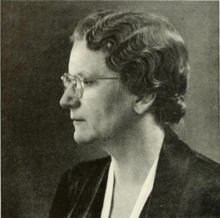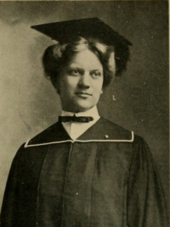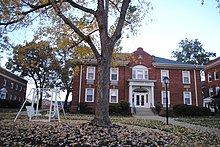Annie Dove Denmark
Annie Dove Denmark | |
|---|---|
 Denmark, c. 1942 | |
| 5th President of Anderson College | |
| In office January 1, 1928 – May 22, 1953 | |
| Preceded by | John E. White |
| Succeeded by | Elmer Francis Haight |
| Personal details | |
| Born | September 29, 1887 Goldsboro, North Carolina, U.S. |
| Died | January 16, 1974 (aged 86) Goldsboro, North Carolina, U.S. |
| Resting place | Willow Dale Cemetery Goldsboro, North Carolina, U.S. |
| Education | |
| Signature | |
Annie Dove Denmark (September 29, 1887 – January 16, 1974) was an American music educator and academic administrator who was the fifth president of Anderson College (now Anderson University) in Anderson, South Carolina, from 1928 to 1953.
A talented musician in her youth, Denmark attended the Baptist University for Women (now
Denmark took office as Anderson's fifth president in January 1928; she is commonly cited as the first woman president of a college or university in South Carolina, though this claim is incorrect. Taking on the school's substantial debt, she guided the school through the
She was the recipient of multiple honors during her life and following her death: Furman University awarded her an honorary degree in 1941, Anderson established the Denmark Society and the Annie Dove Denmark award in 1944 and 1976, respectively, she was made the namesake of a dormitory building on campus in 1966, and was inducted into the Anderson County Museum Hall of Fame in 2004.
Early life and education

Annie Denmark was born in Goldsboro, North Carolina, on September 29, 1887, the fourth of five children[a] born to Sara Emma (née Boyette) and Willis Arthur Denmark.[2] Her family had lived in Goldsboro for some time before her birth; her father moved there several years prior to the Civil War and was the Wayne County tax collector for 33 years.[1] In addition to being an alderman in the town, he was co-founder of a church where he was superintendent of the Sunday school and a deacon.[3] Sara was Willis's second wife; his first wife, Clarissa Boyette, was Sara's sister and had died about two years after the birth of their first and only child.[4] Willis and Sara married eleven months following Clarissa's death.[1] Annie was raised with close ties to the church; she was later described by the Anderson University historian Hubert Hester as a "gifted student" in music,[4] even playing organ at her church between 1897, at the age of ten,[5] until 1908.[6] She received her high school diploma in 1904 from the Goldsboro public schools[4] and enrolled at the Baptist University for Women (BUW) in Raleigh, North Carolina, later the same year.[7]

While at BUW, which changed its name to Meredith College the year after Denmark graduated,[8] she was the president of a literary society for a year and was a member of the student council.[7] One of her instructors there was Grace Louise Cronkhite,[7] who later became her close friend and was dean of music at Anderson, in addition to teaching piano, organ, and music theory, during her presidency.[9] Denmark gave her graduating piano recital on April 22, 1908,[10] and received an artist's diploma in piano a short time later.[7] She continued to take instruction from Cronkhite for a year following her graduation.[7] She also took graduate courses at Columbia University.[11]
Career
Teaching career and start at Anderson, 1908–1927
Denmark accepted her first teaching position in 1908, shortly after her graduation from college, and taught during the 1908–1909 academic year at Buies Creek Academy—now
White resigned as president of Anderson effective September 1, 1927, leaving the position vacant.[18] A committee formed from three members of the school's Board of Trustees was created in order to name his successor.[18] R. H. Holliday, the business manager of the school, was named acting president in the intervening three months[19] while the new permanent president was being selected.[18] Denmark was not the first choice of the Board of Trustees: Charles E. Burts and R. C. Burts, brothers who were both from Newberry, South Carolina, each refused the job, and A. J. Barton, from Nashville, Tennessee, could not agree to terms with the board and therefore did not take the job either.[18] Though little is known about the exact events that led to Denmark's election, it is known that her name was put forward for consideration by college trustee J. Dexter Brown and that the Board of Trustees were in unanimous support of her appointment to the presidency when asked at their meeting on December 15, 1927.[20]
President of Anderson College, 1928–1953

Denmark took office and became Anderson's fifth president on January 1, 1928.
As the school entered the 1930s and the Great Depression, it fought to maintain membership in the Southern Association of Colleges and Schools, which required members to have an endowment of no less than $500,000 (equivalent to $9,120,000 in 2023), of which Anderson at this point had built up not even one-fifth.[30] This, among other reasons, contributed to a decision by Denmark and the trustees to convert Anderson to a junior college.[31] The trustees voted in favor of this plan, and it was brought before the Baptist State Convention on December 4, 1929, at their meeting in Spartanburg. It was approved after much debate.[32] Anderson opened its doors as a junior college for the first time at the start of the 1930–1931 academic year,[33] making it the first junior college in the state.[15] The college became co-educational the following year, admitting its first male students in 1931.[15] Two years following the switch, enrollment had increased by 27 percent. The college reported a total of 199 enrolled students in 1931–1932.[34] Around this time she published White Echoes, a collection of sermons preached by her predecessor, John E. White, during his time in charge of Anderson's First Baptist Church.[35]
Much of the administration's attention was focused on the school's financial troubles and the establishment of a college radio broadcasting station for the next several years.[36] The debt grew larger as the middle of the decade neared and in 1935–1936 the college was paying $3,600 (equivalent to $80,000 in 2023) yearly in interest alone to the Hibernia Trust Company.[37] Denmark and the trustees planned a large dinner to spur the fundraising campaign on April 6, 1936, though the dinner was canceled after an F2 tornado—one that was part of a larger outbreak over the course of that and the previous day—struck the city of Anderson that afternoon resulting in thirty injuries[38][39] in addition to the loss of two mills and several homes and farms in town.[38] The college did, however, collect $20,000 (equivalent to $439,000 in 2023) as a result of their storm insurance policy, which went towards restoring the heating plant and other general refurbishments.[40] The school administration won a significant victory two years later when, on May 23, 1938, the South Carolina Baptist Convention assisted in paying the remainder of Anderson's debt, bringing many of the school's financial woes to a close.[41]
Enrollment climbed over the next few years and spiked noticeably after World War II; 42 of 53 men that enrolled at Anderson in 1946–1947 were veterans, largely a result of the G.I. Bill, and the school enrolled a record 409 students that academic year in total.[42] Denmark helped to increase pay for Anderson faculty on multiple occasions: in May 1944, she recommended a "slight increase" in their salaries and introduced a salary bonus in March 1946.[43] The college, still in some need of funds and a stable endowment, received $60,000 (equivalent to $937,000 in 2023) from the Baptist State Convention sometime between 1946 and 1947, which was used to modernize some of the campus's buildings.[44] In 1944, she worked with school administration to implement an honor code for the college under which students would be tried by their classmates,[45] though some infractions (such as alcohol possession) meant a student would be subject to expulsion with no debate.[46] Throughout her presidency, she kept close the college's ties with the church, as chapel attendance remained a requirement for all students, five days a week, up to and through her resignation.[47]
At a meeting of the Board of Trustees on April 23, 1952, Denmark announced her resignation as president of the college, saying,
I am herewith tendering to you as representing the Baptist State Convention of South Carolina, my resignation to take effect on January 1, 1953, or as soon thereafter as my successor can be found.[48]
This date represented the 25th anniversary, to the day, of the beginning of her term, though her successor was ultimately not found until several months later.[49] In her letter, she referenced the school's freedom from debt and good prospects for future financial support as well as her desire to allow the new president enough time to prepare for the next academic year.[48] The trustees were quite surprised by this request and did not accept her resignation until the conclusion of the meeting, when she insisted that they do so.[49] She gave her final president's report on January 22, 1953; at the same meeting, president-elect Elmer Francis Haight was introduced to the trustees.[50] "Denmark Day" was celebrated on Founders Day of that year—February 14, 1953—during which the retiring president was honored by many former students and other guests of the college.[51] Her official duties as president came to a close following the commencement exercises of May 22, 1953.[52] President Haight began his duties as Anderson's sixth president the following month.[52]
During her presidency, Denmark held a number of other positions within higher education: she led the Southern Association of Colleges for Women as its president from 1934 to 1935,[53] was a member of the Board of Trustees of the Southern Baptist Women's Missionary Union Training School in Louisville, Kentucky, and was the first woman to hold an office in the Baptist State Convention when she was its vice president in 1950.[15]
Later life and death
On Denmark's final day as president, the college's trustees elected her president emeritus and extended her an invitation to remain living on campus for the rest of her life.[54] While she accepted the position, she opted to return to her hometown of Goldsboro.[15] She assumed several hobbies in her retirement, including collecting Madonnas and watching baseball.[55] After suffering declining health for several months, she died on the morning of January 16, 1974, at Wayne Memorial Hospital in Goldsboro,[15] at the age of 86.[56] She never married and left no immediate family.[55] Memorial services were held the following day at First Baptist Church in Goldsboro and in Anderson's auditorium.[15] She was buried in Goldsboro's Willow Dale Cemetery.[15]
Legacy

On June 2, 1941,
Notes
- ^ Denmark had an older sister who died in infancy. She had two older brothers and one younger brother who survived to adulthood, so in some sources she is noted as being the third of four children.[1]
- ^ Hester (1969) says that Denmark "attended Chatauqua Institute at Chatauqua, New York, [sic] for 12 summers altogether",[14] though her obituary from The State says that she attended only from 1921–1927 and then again in 1933[15] and Copeland (2011) says that she attended for twenty years.[16]
- ^ Most sources agree that she earned her degree from Anderson in 1925, though Copeland (2011) says "The 1926 graduating class of Anderson College lists the name of Annie Dove Denmark."[17]
- ^ There is some slight disagreement among sources regarding the year that Denmark relinquished her position as dean of women; Hester (1969) and her obituary published by The State say that she was not in the role when she accepted the presidency (the former says she left the position in 1928 and the latter in 1926),[7][15] though a story by The News & Observer published in 1929 states that she kept the position upon becoming president.[13]
References
- ^ a b c Copeland 2011, p. 23.
- ^ Howes 1935, p. 141.
- ^ Hester 1969, pp. 57–58.
- ^ a b c Hester 1969, p. 58.
- ^ a b "Annie Dove Denmark: 2004 Hall of Fame". Anderson County Museum. Archived from the original on September 22, 2021. Retrieved August 19, 2022.
- ^ a b c d e "Chronological Table of the Life of Dr. Annie Dove Denmark". Anderson University. Archived from the original on August 19, 2022. Retrieved August 19, 2022.
- ^ a b c d e f g h i j k l m Hester 1969, p. 59.
- ^ "College Timeline". Meredith College. Archived from the original on June 7, 2023. Retrieved August 7, 2023.
- ^ "Anderson College School of Music". Anderson College Viewbook. Vol. XVI, no. 1. Anderson, South Carolina: Anderson College. July 1933. p. 7. Archived from the original on August 23, 2022. Retrieved August 23, 2022.
- ^
- ^ Copeland 2011, p. 33.
- ^
- ^ a b c Hester 1969, p. 60.
- ^
- ^ Copeland 2011, p. 36.
- ^ Copeland 2011, p. 22.
- ^ a b c d Hester 1969, p. 64.
- ^ Copeland 2011, pp. 17, 68.
- ^ Hester 1969, pp. 64–65, 166.
- ^ Hester 1969, p. 68.
- ^ Copeland 2011, p. 13.
- ^ Hester 1969, p. 87.
- ^ a b Hester 1969, p. 65.
- ^ a b c d "Women's History Month: Dr. Annie Dove Denmark was a pioneering president at Anderson". South Carolina Independent Colleges & Universities. March 19, 2022. Archived from the original on August 30, 2022. Retrieved August 19, 2022.
- ^ Wood 2011, p. 24.
- ^ Hester 1969, p. 69.
- ^ Hester 1969, p. 74.
- ^ Hester 1969, pp. 74–79.
- ^ Hester 1969, p. 80.
- ^ Hester 1969, p. 81.
- ^ Hester 1969, p. 86.
- ^ White & Denmark 1932.
- ^ Hester 1969, pp. 91–92.
- ^ Hester 1969, p. 93.
- ^ a b Grazulis 1990, p. 260.
- ^ "30 Hurt at Anderson, S.C." The New York Times. April 7, 1936. p. 10. Archived from the original on August 24, 2022. Retrieved August 24, 2022.
- ^ Hester 1969, p. 94.
- ^ Hester 1969, p. 95.
- ^ Hester 1969, p. 99.
- ^ Hester 1969, p. 100.
- ^ Hester 1969, p. 102.
- ^ Copeland 2011, p. 56.
- ^ Copeland 2011, p. 57.
- ^ Copeland 2011, p. 54.
- ^ a b Hester 1969, p. 104.
- ^ a b Hester 1969, p. 105.
- ^ Hester 1969, p. 108.
- ^ Hester 1969, p. 107.
- ^ a b Hester 1969, p. 109.
- ^ Wood 2011, p. 20.
- ^
- ^ Rouse, John Edward (May 31, 1961). "Fiftieth Anniversary Certificate of Service". Letter to Annie Dove Denmark. Retrieved August 25, 2022.
- ^ "Housing". Anderson University. Archived from the original on October 24, 2021. Retrieved August 24, 2022.
- ^ Hester 1969, p. 148.
- ^ "The Denmark Story – A Historical Play". South Carolina Humanities. August 12, 2010. Archived from the original on October 27, 2021. Retrieved August 19, 2022.
- ^ "The Denmark Story Goes on Tour". South Carolina Humanities. December 14, 2010. Archived from the original on February 1, 2023. Retrieved August 8, 2023.
- ^ "The Denmark Story: A dramatic telling of AU's longest-serving president". Anderson University Magazine. Anderson, South Carolina: Anderson University. 2011. p. 36. Archived from the original on August 24, 2022. Retrieved August 23, 2022.
- ^ Hester 1969, p. 106.
- ^ Copeland 2011, p. 25.
Bibliography
- Howes, Durward (1935). American Women: The Official Who's Who Among the Women of the Nation. American Publications. OCLC 1196378808.
- Copeland, Kathryn (2011). Millwood, Linda; Martin, Anne Marie; Wade, Bethany (eds.). Dr. Annie Dove Denmark, South Carolina's First Female College President. OCLC 730005366.
- OCLC 23024433.
- Hester, Hubert Inman (1969). They That Wait: A History of Anderson College. OCLC 118105.
- White, John Ellington; Denmark, Annie Dove (1932). White Echoes: A Volume of Echoes from Sermons Preached by John Ellington White During His Pastorate of the First Baptist Church, Anderson, S.C. Sunday School Board of the Southern Baptist Convention. OCLC 6511510.
- Wood, Joyce (2011). Anderson University. OCLC 663953618.
